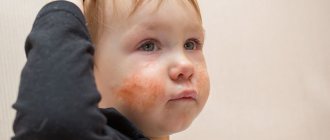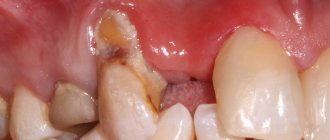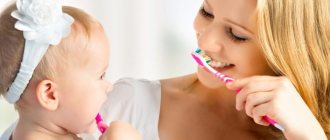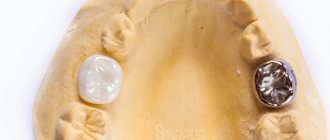It is important to keep baby teeth healthy, despite the fact that they are replaced by molars over time, because the latter depend on the quality of the former. Without proper cleaning, caries quickly develops on baby teeth, which can turn into permanent ones, sometimes even at the stage of their formation. In addition, early loss of baby teeth often causes permanent teeth to shift and cause problems with bite. To avoid these negative consequences, it is important to take care of your teeth from childhood, and in this article we will tell you how to teach your child to do this.
Teaching your baby to take care of his teeth
When should you start brushing your teeth?
From the moment the first tooth appears, which can erupt between the ages of five and eight months. Most often, the central incisors on the lower jaw appear first.
This is preceded by a period when the gums swell and bother the child. To alleviate the condition, you can give your baby a teething brush - it looks just like a regular one, but has thick and soft rubber bristles that massage the gums without injuring them. The baby will hold it himself, move it along the gums, bite the bristles to relieve itching, so he will quickly get used to the brush and the teeth cleaning procedure.
The teether has soft and thick bristles
When a child's first incisors appear, it is important to clean them with a children's toothbrush with rubber bristles. This procedure cannot be neglected, since at this age the baby eats liquid food, and only solid food (for example, raw carrots or apples) contributes to the process of self-cleaning of the oral cavity. Therefore, it is important to help the child get rid of plaque.
To begin with, let the baby touch the brush, examine it, and try to move it over the teeth himself. This will help him get used to the new subject. After this, you can begin the cleaning itself. It is important to brush your teeth correctly: move the brush from the gum to the edge of the tooth and do not forget about the inner surface.
Let your child try brushing his teeth so that he gets used to the procedure/figcaption>
In addition, the appearance of the first teeth is a reason to take the baby to the dentist. First, the doctor will evaluate the quality of the enamel and help prevent possible problems that may appear at an early age. Secondly, over time, such examinations will become something ordinary for the child and will not cause fear.
What do we know about baby teeth?
The first milk teeth appear in children from 5 to 8 months . The final growth of baby teeth occurs around the age of three , and the replacement of baby teeth with molars begins at the age of six . The process of changing baby teeth is quite long and can last up to 14 years .
Milk teeth differ from molars , primarily by the lower part of the tooth, hidden by the gum. Baby teeth lack a long root that holds the molar in the gum. Baby teeth are smaller in size than molars. A slight curvature of baby teeth should not cause concern - the position of the teeth can change as the child grows up.
Baby teeth are formed long before birth in the mother's womb . The child takes the substances necessary for this (primarily calcium) from the mother’s body. That is why pregnant women are recommended to take vitamins specially designed for them. If there is a lack of calcium in the mother’s body, her own teeth are in danger of trouble.
How to convince a child to brush his teeth?
If a child has not brushed his teeth since infancy, he will find the new procedure interesting the first or second time. And when he realizes that this is a daily activity, he may begin to “forget” or openly protest. In this case, we recommend proceeding as follows:
- Eliminating negativity.
If your child is angry or crying and doesn't want to brush his teeth, don't force him to comply at all costs. Don’t scare him with the words: “If you don’t brush your teeth, I’ll take you to the doctor.” This way he will become afraid of dentists. In addition, do not promise rewards: “If you brush your teeth, I’ll let you play some more before bed,” otherwise it will be difficult to refuse this scenario later.
Instead, allow him to express his emotions and don't scold him for them. Say: “I see you are upset/angry. You don’t feel like brushing your teeth.” When a person feels that he is understood, the degree of negativity decreases. You can give him a piece of paper and ask him to show how upset or angry he is. If your child, for example, crumples up paper or scribbles something furiously, say, “I understand that you are very angry.”
Do not scold your child for negative emotions, allow him to express them
- We brush our teeth together.
Show your child by personal example that brushing teeth is a daily procedure, obligatory even for parents. You can create a common ritual when dad, mom and baby brush their teeth together. This will allow the child to understand that he is in some way equal to his parents, since he has the same responsibilities.
Show him how to brush his teeth properly, and even if he is too slow at first, do not rush him and encourage him.
- We allow the child to show independence.
Let your child choose his own toothbrush and toothpaste. This will make him feel more independent. In addition, the process will be more interesting for the child if the brush or toothpaste packaging depicts favorite cartoon characters.
To prevent the procedure from being too short, buy an hourglass that measures two minutes and place it in the bathroom. This way your baby will be able to control the time himself.
The plaque indicator will give a rich color to poorly cleaned areas and motivate your child to brush their teeth more thoroughly.
- Discuss dental health with your children.
Offer cartoons and books about dental care and discuss what the child learned from them. Often there are stories told about heroes who did not brush their teeth, and as a result they got sick.
In addition, you can invite him to play dentist and buy a toy that needs to be used to fix his teeth. This will give your child information about why they need to take care of their mouth.
By playing out different situations, the child stops being afraid of doctors and understands the importance of dental care
Caries of baby teeth
Children's teeth have weakly mineralized enamel, especially immediately after eruption. Therefore, they are more vulnerable to decay-causing microorganisms than adult teeth. Decay in primary teeth is usually found in children aged 2-3 years, and in some cases it occurs in children under 2 years of age. Most often, caries affects the deciduous incisors of the upper jaw and the chewing surface of the molars. Particular attention in pediatric dentistry is paid to preventive methods that prevent the occurrence of caries.
Child's visit to the dentist
should occur in the first days after birth. In the future, it is recommended to visit the dentist 2 times a year if the child has no problems with his teeth. If so, then every 3 months. This is much more correct and profitable than treating advanced caries and its complications. During the visit, the doctor will carefully examine the child’s teeth and oral cavity, remove plaque and dental deposits. If there are small carious lesions, the doctor will heal them without waiting for complications. The hygienist will give recommendations on caring for the child’s teeth and oral cavity, and will tell you how to choose the right toothpaste and brush.
Peculiarity of childhood
consists in the rapid occurrence of life processes in the child’s body. Therefore, the development of pathological processes proceeds too quickly. Today you see healthy baby teeth in your child, and a month later you discover caries. The dentist will identify systemic disorders and, if necessary, prescribe the necessary vitamin and mineral complexes and medications. Fluoridation compounds for children's teeth effectively prevent the development of caries. Preventive examinations and professional teeth cleaning will not cause fear in the child and will contribute to a trusting relationship with the doctor. Early diagnosis will allow for simple, painless and inexpensive treatment.
How does caries occur in baby teeth?
A huge number of microorganisms live in the oral cavity. It is necessary to prevent their excessive growth, as this leads to the formation of plaque and then caries. Caries is tooth decay that begins with the dissolution of the mineral substances that make up the enamel. Self-cleaning of teeth is facilitated by saliva, which has bactericidal properties. But plaque still accumulates on hard-to-reach surfaces of teeth, in which bacteria “linger.” Like most children, bacteria have a sweet tooth. They feed on carbohydrates and produce acid, which destroys apatite crystals (tooth enamel is made up of them). These processes are asymptomatic, i.e. without pain. The enamel of baby teeth is very thin, which is why it becomes easy prey for bacteria, which then reach the dentin, the main tissue of the tooth. Dentin is much softer than enamel and therefore deteriorates faster than enamel. Therefore, even with a small hole in the enamel, dentin damage can be serious. This is why carious children's teeth do not look bad for the time being, although the destruction inside the tooth can be great.
Caries of primary teeth can be initial, superficial, medium and deep. With initial caries, white spots of various shapes and sizes appear on the enamel of a baby tooth. Their number may increase. There is no pain. If treatment is not carried out, the process will progress: the spots become dark, brown, black, and the disease can become chronic. With timely treatment, further development of initial caries can be stopped.
Superficial caries is a defect in tooth tissue located within the enamel. A carious cavity can be light or dark. At this stage of the lesion, pain appears when exposed to sweet, sour, salty foods. The treatment method for this form of caries is filling the cavity. In some cases, filling can be replaced by remineralizing therapy.
With average caries, the tooth enamel and part of the dentin are affected. Pain can occur from sweet, salty, cold and hot foods. At this stage, treatment involves treating the carious cavity followed by filling.
In the case of deep caries, the enamel and most of the dentin are affected. The treatment method here depends on the condition of the pulp; it can be filling or conservative treatment.
How to choose a toothbrush?
The main thing when choosing is the material of the bristles: it should be synthetic, since natural materials do not dry well and microbes can accumulate in them. In addition, it should be soft or ultra-soft.
Children aged from one to two years need a brush with a head no more than 1.5 cm and a handle no longer than 10 cm. It is recommended to choose models with rubber or silicone inserts on the handle so that they do not slip out of the hands. From two to five years, a brush with a head length of 2 cm and a handle of 15 cm is suitable, and from five to seven years - 2.5 cm and 17 cm, respectively.
Children aged three years and older can use an electric toothbrush. Firstly, it will clean your teeth better. Secondly, often such brushes can be synchronized with a smartphone. This way, the child will be able to keep track of the procedure time and see on-screen tips on how to brush their teeth correctly.
It is necessary to change a regular brush or an electric brush head every two to three months, and also immediately after the child has had an infectious disease, such as a cold.
Measure the brushing time using an hourglass, so the child will understand how much time is left until the end of the procedure
First year of life
When you hear the ringing sound of a spoon touching the first incisor, do not rush to run for a brush.
For infants up to one year old, there are their own care products:
- silicone fingertip;
- sterile bandage;
- dental wipes.
The advantages of the listed means are that they are worn on the finger. This allows you to feel the gums and adjust the pressure.
The most inexpensive way is to use a bandage or gauze soaked in water or soda solution. A small amount of bandage is moistened, wrung out and wrapped around the finger. The gums, tongue and inner surface of the cheeks are treated.
Purchasing dental wipes will hit your pocket much more. They are intended for one-time use, treated with a special antiseptic solution that is safe for the baby. Neutral in taste, will not leave any unpleasant sensations in the baby.
Children's stores have a huge selection of silicone fingertips. For the first manipulations, it is better to choose a smooth attribute.
For older babies, you can offer finger pads with silicone bristles. They are more reminiscent of a toothbrush and massage the gums better. After each use, wash in running water. Boil before first use.
How to choose baby toothpaste?
It is important to focus on the level of its abrasiveness. This indicator tells how much the composition erases tooth enamel when brushing, and is denoted by the abbreviation RDA. For children, a maximum of 20 RDA is acceptable, while for adults a level of 70 to 100 is safe.
In addition, baby toothpaste should not contain calcium carbonate and sodium bicarbonate, as these are harsh abrasives that can damage enamel. Instead, it is better to choose formulations with titanium or silicon dioxide.
Sodium lauryl sulfate, or SLS, is also toxic for children; it can dry out the mucous membranes and cause allergies. However, it is safe for adults. It is added to the paste to give it foaming properties. Accordingly, if the toothpaste produces abundant foam, this component is present in it.
To make it easier for your child to get used to the procedure, brush your teeth with him
The same reactions - dry mucous membranes and allergies - can be caused by parabens, which are used to preserve the composition and give it antiseptic properties.
Regarding fluoride content, the European Academy of Pediatric Dentistry (EAPD) recommends toothpastes with this component for everyone, including children after the eruption of their first tooth. Fluoride is necessary for the prevention of caries. In paste for children under four years old it should contain 200 ppm, children from four to eight years old need 500 ppm, and after eight years old - 1450 ppm.
In addition, fluoride has an alternative - synthetic hydroxyapatite, which is identical to natural hydroxyapatite, which makes up tooth enamel. This substance is easily integrated into the crystal lattice and strengthens it, sealing all microcracks, reduces sensitivity and prevents the development of caries. The only disadvantage of pastes with hydroxyapatite is that they are more expensive than fluoride ones.
The sooner you start paying attention to your child’s oral cavity, the faster and easier he will learn to take care of his teeth. If the baby was not taught to brush his teeth while he was very young, everything can be corrected. The main thing is to be patient and act consistently, then over time the procedure will become a familiar ritual for him
At what age should you brush with toothpaste?
Toothpaste must be rinsed thoroughly. Children can cope with this procedure until they are two years old. The amount of paste at first should be the size of a pea.
The toothpaste for children under 3 years of age does not contain fluoride. Also, products with antiseptic components (for example, chlorhexidine or triclosan) are not suitable for daily use. They have a detrimental effect on local immunity and disrupt the microflora.
But there is nothing to worry about if your baby swallows a little baby toothpaste. The composition is absolutely harmless to health.
Teeth Brushing Sequence
You, parents, will be an excellent example. Show how you brush your teeth yourself, the child will remember better. So, follow a simple algorithm:
- It is better to start from the outside of the mouth. It is better to take the brush at an angle of 45 degrees.
- Then move on to the inside of the dentition.
- Don't forget to pay attention to the chewing surface. In this case, place the toothbrush horizontally.
- You also need to clean your tongue.
- At the end, you can treat the oral cavity with dental floss.










